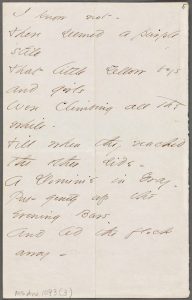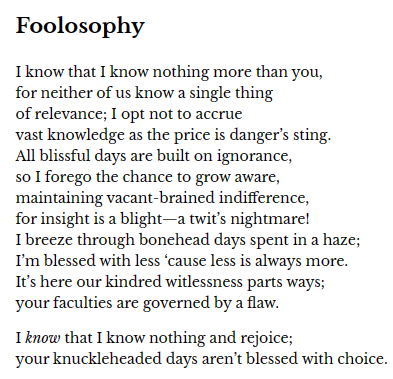Nov
25
Comparitive Research Report
November 25, 2023 | Comments Off on Comparitive Research Report
The two pieces of writing I will be exploring are “Forever – is Composed of Nows” by Emily Dickinson and “Foolosophy” by Susan Jarvis Bryant. Dickinson’s writing represents literature created traditionally and Bryant’s literature represents writing created digitally. In the poem, Dickinson explores various elements like the importance of being present in the present and the present being everlasting. She states “‘Tis not a different time” meaning that the past, present, and future are occurring all at once; this reinforces the whole meaning behind her poem, to enjoy the present. On the other hand, Bryant explores concepts that involve the bliss of ignorance. She explains within the poem that being unaware of our reality is peaceful and too much knowledge is dreadful. Bryant states “All blissful days are built on ignorance, so I forego the chance to grow aware” This quote emphasizes Bryant’s statement that not acknowledging the reality of the events occurring around you or occurring in general, allows you to have a sort of peace of mind. She then continues to explain that knowing less is more and knowing more is a disservice to us. Dickinson and Bryant both convey their message through the same type of literature, poetry. In the poem “Forever – is composed of Nows”, themes like endlessness and the present are discussed and in “Foolosophy”, themes like not being aware can bring peace. These themes are comparable because they discuss enjoying the present moment; Bryant’s piece focuses on our current knowledge and how we react or engage with the things that surround us, while Dickson’s piece focuses on the importance of the present. The structure of these two poems is relatively short lengthwise and the poems are both structured as free verse poetry. Although these two poems have the same type of structure and similar themes, there are a few differences between these two poets and their writings. Emily Dickinson created “Forever – is Composed of Nows” in 1830, while Susan Jarvis Bryant created “Foolosophy” was created around 2020. One of the first things I noticed while reading their writings and then comparing their work was their word choice. In Dickinson’s poem, she uses old English compared to Bryant’s piece which contains modern English. Dickinson also used lots of punctuation within her poem; for example, Dickinson used dashes within almost every line while Bryant used this form of punctuation within only one line of the whole poem. Another aspect I realized while reading their poems is that Dickinson capitalized most of the words within her poem, while Bryant capitalized her words at appropriate moments. I believe Dickinson chose certain words to capitalize in order to convey to the reader the importance they have in the entirety of the poem. Ultimately, both of these poems were beautifully written and had aligning concepts but different deliveries to their audiences.

